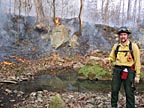December 02, 2005
Diploma just the beginning for Saluki Fire Dawg
CARBONDALE, Ill. -- If Brian E. Bolser ever wondered whether he really wanted to fight forest fires for a living, his summer job in a factory turned out to be a surefire persuader."I dreaded going into work every morning," said Bolser, a Rochester senior who will graduate from Southern Illinois University Carbondale Dec. 17 with a degree in forestry.
"A lot of people who worked in the factory encouraged me to chase my dream — they were older and stuck there."
Bolser's dream — fighting fires in the West's wild lands — began taking shape while he was still in high school. He knew he wanted to work in a job that somehow involved the great outdoors. When he visited SIUC's plant biology department to talk about a major, the professor who met with him just happened to be a former smoke jumper — a forest fire fighter who parachutes into remote areas to battle the blazes.
"He recommended that I go into forestry," Bolser recalled.
"I figured that if he was telling me to go to another department, that was probably what I wanted to do."
Once enrolled, it didn't take Bolser long to connect with SIUC fire ecologist Charles M. Ruffner. Ruffner runs the Saluki Fire Dawgs, a band of forestry majors trained to both set and put out fires as part of managing and maintaining state and federal forests.
To go to the Dawgs, students must take Forestry 315, Fire in Wildland Management, where they combine book learning about fire with hands-on tutoring in the tools of the trade. A pass in the course plus demonstrated ability to carry a 45-pound pack three miles in less than 45 minutes earns them the coveted "red card" — evidence that they know the basics of firefighting and can work a fire line.
"You're supposed to be a junior to take that class, but he let me in," Bolser said with a grin.
With the red card under his fire belt, Bolser never had to go back to the factory. When it came time to look for a summer job, he searched the federal government's online postings for seasonal firefighting posts, picked his top 10 and began calling the people with the power to hire him.
"When I told them I had the fire class, I had a red card already and I was a forestry major, they were really interested," he said.
"Just having that little bit of experience helped a lot. It put me a step ahead."
That first summer, Bolser snagged a job with the crew of the Espanola fire district's Station No. 7 in Santa Fe, N.M., fighting fires in the national forest that backs up on the city. He's returned there every summer since, working 10 hours a day, six days a week.
"The best part of the job is that every day is different," Bolser said.
"You never do the same thing two days in a row, and every moment is exciting."
Bolser said his first fire stands out in his memory, though it wasn't large, involving only about two acres.
"It was the first fire I'd been on, and my first helicopter ride," Bolser said.
"That's such a cool way to go to work — it's not your typical morning commute."
Last summer, Bolser got sent to Arizona to help fight the Cave Creek fire 40 miles north of Phoenix. Started by two lightning strikes June 21, the fire continued to blaze until mid- July; it was the second largest fire Arizona had ever experienced.
"Before that, every fire I had been on was small — one or two acres," Bolser said. "This was 250,000 acres.
"I was a little nervous going up to it. When you can see a smoke trail from four hours north of the fire, you know it will definitely be different."
Bolser's crew went to Black Canyon City, a town of some 4,500 people near the fire's southern zone. They toured the city house by house to determine which ones they could save if the fire moved in, then cleared the surrounding areas of grass, brush, shrubs and trees. They moved portable water tanks and sprinklers into position so they could wet down the fields around the houses if the fire got too close. And then they waited.
"We were there five days, and the fire never came through the town, but I learned a lot — the fire was totally different from what I was used to," Bolser said.
Though Bolser will receive his SIUC diploma in a couple of weeks, he's not done with school. Fire officers from New Mexico's Espanola district have agreed to sponsor him in a three-year apprenticeship program where, after two months at a fire academy in Sacramento, Calif., he will train with seasoned helicopter, engine and smoke jumper crews.
"I have no idea where they will send me or what exactly I'll be doing," Bolser said.
"I think that's what scares people – you're at their mercy. But I want to learn to do all that stuff so this saves me from going through the application process every year."
Bolser has already learned one crucial thing that will serve him well in the years to come.
"When I first started, I used to tell my mom whenever I was on my way to a fire — that was a mistake," he said with a laugh.
"When I turned my phone back on after two or three days, I'd have 15 voice mail messages."
Bolser said his mom, Barbara A. Bolser of Champaign, thought he was crazy when he first began fighting fires. These days, she's "sort of desensitized," he said.
"I think she's proud — but she still worries."
Shaping high-quality undergraduate programs is among the goals of Southern at 150: Building Excellence Through Commitment, the blueprint the University is following as it approaches its 150th anniversary in 2019.

